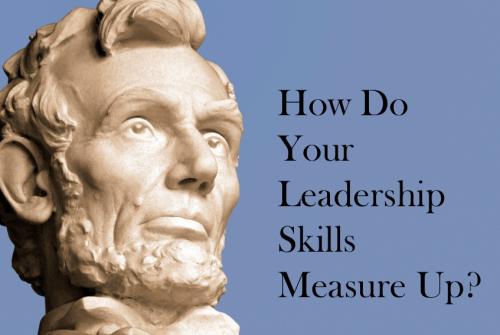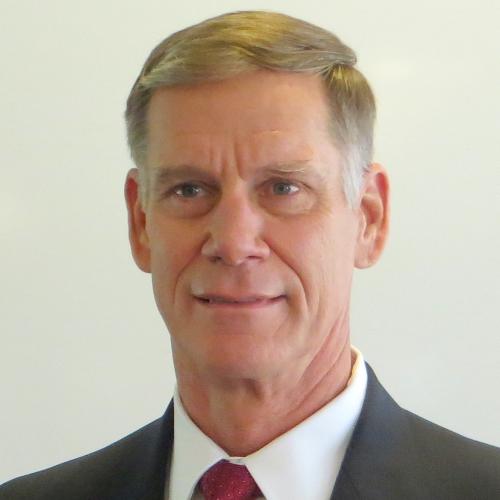 As February annually asks us to reflect on our Presidents, it too allows us to reflect on our own leadership and leaders in our organizations. I cannot help but reflect on the leadership capabilities of our 16th President. As we lament the divisiveness of our current national political dialogue and the uncertainty and ambiguity it creates geopolitically for business, political, military and global leaders, I am reminded that our nation has suffered greater challenges and pulled through them. How? The leadership of executives with clarity of purpose, an understanding of the strategic environment, the ability to select the right leadership team, possession of communicative and interpersonal skills, and the determination, drive and energy to see the task through to completion. Abraham Lincoln demonstrably displayed these timeless core enterprise leadership capabilities as he saved the Union and guided our young nation through its greatest domestic turmoil.
As February annually asks us to reflect on our Presidents, it too allows us to reflect on our own leadership and leaders in our organizations. I cannot help but reflect on the leadership capabilities of our 16th President. As we lament the divisiveness of our current national political dialogue and the uncertainty and ambiguity it creates geopolitically for business, political, military and global leaders, I am reminded that our nation has suffered greater challenges and pulled through them. How? The leadership of executives with clarity of purpose, an understanding of the strategic environment, the ability to select the right leadership team, possession of communicative and interpersonal skills, and the determination, drive and energy to see the task through to completion. Abraham Lincoln demonstrably displayed these timeless core enterprise leadership capabilities as he saved the Union and guided our young nation through its greatest domestic turmoil.
Five Leadership Capabilities of Abraham Lincoln
How do you and your leadership team measure up in these capabilities?
1) Clarity of Purpose; Defining “Why”
Clarity of purpose focuses an organization while simultaneously aligning efforts, empowering subordinates and engendering initiative. Lincoln made clear in his campaign and Presidency that “preservation, protection and defense of the Union” was his highest priority in a pressured environment where the issue of slavery divided the nation. The ability to focus on the end-state, a unified United States, while recognizing an untimely focus on solving the slavery issue might endanger achieving success, demonstrates a leader’s imperative to negotiate the volatile, uncertain, complex, and ambiguous environment in order to provide clarity of purpose to the enterprise. In the Army, we use ‘Commander’s Intent” or Leader Intent to communicate the vision by describing the purpose or the why of an undertaking, what must be done, and what success (the end-state) looks like. General George Patton states this principle in his own words: “Never tell people how to do things, tell them what you want to do and they will surprise you with their ingenuity”.
Do you have clarity of purpose in your organization? Do you have confidence that your leadership team understands your purpose and the “why” of your undertaking?
2) Aligning Activities to Achieve a Shared Vision or End-State
A military example in Lincoln’s team demonstrates understanding of the end-state and nesting the Army’s tasks inside of that purpose. In April 1864, General Grant issued an order to General Sherman: “…move against Johnston’s Army, break it up and get into the interior of the enemy’s country as far as you can, inflicting as much damage as you can against war resources. I do not propose to lay down a plan for the campaign but simply lay down the work that is desirable to have done and leave you free to execute in your own way. Submit to me however as early as you can, your plan of operations…” Grant’s focus was the destruction of the Confederate Armies, a central tenant of Lincoln’s strategy. In order to have a single Union, the Confederate Army must cease to exist or the conflict and the Confederacy could continue, and continued fighting could pressure the President to end the war and negotiate a two-nation solution. The nesting of military purpose with the President’s end-state, to preserve Union, is a classic example of aligning the enterprises activities to achieve the shared vision or end-state. Grant’s “Commanders Intent” gave Sherman great freedom of action in how to accomplish the task; yet, wisely, required his plan of action to verify his alignment with the President’s and his own intent. General Sherman’s march to the sea, which burned food, destroyed road, rail and bridges, freed slaves, damaged and weakened the psyche of the southern people and Army, ultimately leading to the final surrender at Appomattox.
Is your organization aligned in purpose with nested intent and with each organizational element supporting the enterprises’ end-state?
3) Understanding the Strategic Environment & Selecting the Right Team
Understanding the strategic environment is critical for organizational leaders to navigate a path to clarity of purpose, the identification of critical tasks and ably describing what success looks like. Abraham Lincoln accomplished this through:
-
First, the selection of a cabinet described as a “Team of Rivals” in Doris Kearns Goodwin’s Pulitzer prize winner of the same title.
-
Second, the ultimate selection of military leaders who understood and supported his strategy and shared his vision.
-
Third, countless hours of listening to political leaders of states, parties, and communities.
-
Fourth, engaging with industrialists, abolitionists, anti-war factions, and newspaper publishers in order to understand, analyze and digest the complexities of the strategic environment.
The effort required of President Lincoln was Homeric; raising armies, raising foreign and domestic capital, balancing border state loyalties and commitment to the Union while artfully negotiating through Executive authority, the Emancipation Proclamation of 1863, freeing the slaves in 11 southern states under the logic that slaves were material support to the Confederate Army, running a successful campaign for re-election, passage of the 13th amendment abolishing slavery and freeing all slaves and throughout 4 years maintaining the focus of all parties on preserving the Union. Understanding his strategic environment was accomplished through intense listening, engaging all factions and viewpoints, and assessing and acting in alignment with his strategic end-state.
How do you collectively analyze and understand your environment? Who is your “team of rivals”? Have you selected the right leadership team, and do they share the vision and end-state for your enterprise? Has your enterprise clearly articulated your vision, purpose, and end-state effectively? Does your work force from C-Suite to salesperson understand the “why” of your undertakings?
4) Demonstrating Interpersonal Skills & the Ability to Communicate Effectively
Lincoln’s political genius and ability to see with clarity were amplified by his unique ability to communicate effectively. Lincoln spent long hours in the White House telegraph office communicating with military and state government leaders; he routinely visited the battle fields to confer with leaders and talk to groups of soldiers, conveying his strategy to insure clarity and alignment. His speeches, oral and written, conferences with his cabinet, and meetings with Congressional groups were all designed for him to both listen and learn as well as reinforce his positions. Lincoln enjoyed engagement and story telling; he was approachable and engaging, often stopping work to receive visitors late into the evening. Today we might say that Lincoln embraced “Management by Walking Around.” Seeking feedback, reinforcing messages, and availing himself to his constituencies to enhance understanding, alignment, and support, he was where he needed to be.
How do you communicate with your leadership team and work force? What is your communication style? Are you approachable and a good listener?
5) Exhibiting the Determination, Drive & Energy to See Things Through to Completion
It is a military axiom that we fight the enemy and not the plan, but the ability of a leader to be resolute, determined, and steadfast is crucial to moving a large enterprise to achieve its desired end-state and to realize the vision. Great leaders such as Lincoln seemingly have endless energy and, while sometimes showing the wear and tear of a long struggle, their inner determination keeps them focused on the end-state. Conditions change, planning is continuous but the end-state remains constant and inviolable; preservation of the Union was never a debatable end-state for Lincoln, though many politicians urged him to negotiate an end to the war, but to avoid surrender. The character and values a leader possesses hardens the will, which will surely be tested in crisis. Leadership, in the most complex and uncertain times, requires a resolute purpose, which is simply stated and understood.
Leadership principles and competencies are timeless, and Abraham Lincoln’s example in exhibiting clarity of purpose; an understanding of the strategic environment; the ability to select the right leadership team; interpersonal and communication skills; and the determination, drive, and energy to see the task through to completion, should cause each of us as leaders to revisit our capabilities and assess how we and our organizations measure against Lincoln and his “team of rivals” as they preserved the Union for generations that follow.
 Written by Lieutenant General (Retired) Frank Kearney graduated from the United States Military Academy at West Point in 1976 and has over 35 years of experience leading military and government organizations. General Kearney was the second in command at United States Special Operations Command (USSOCOM) at MacDill AFB, Florida, responsible for training, developing and equipping 58,000 special operators world wide and overseeing execution of an annual $9+ billion dollar budget. He most recently served as the Deputy Director, at the National Counterterrorism Center (NCTC) for Strategic Operational Planning, as well as developing and implementing Strategic Plans for both organizations to achieve their objectives for the United States Government. General Kearney has led teams to reorganize USSOCOM’s 2000 person organization headquarters and to realign the structure of NCTC’s Directorate of Strategic Operational Planning.
Written by Lieutenant General (Retired) Frank Kearney graduated from the United States Military Academy at West Point in 1976 and has over 35 years of experience leading military and government organizations. General Kearney was the second in command at United States Special Operations Command (USSOCOM) at MacDill AFB, Florida, responsible for training, developing and equipping 58,000 special operators world wide and overseeing execution of an annual $9+ billion dollar budget. He most recently served as the Deputy Director, at the National Counterterrorism Center (NCTC) for Strategic Operational Planning, as well as developing and implementing Strategic Plans for both organizations to achieve their objectives for the United States Government. General Kearney has led teams to reorganize USSOCOM’s 2000 person organization headquarters and to realign the structure of NCTC’s Directorate of Strategic Operational Planning.
 Contributed by Karen Kuhla, Ph.D., Executive Director of (TLDG) The Thayer Leader Development Group at West Point. Karen oversees leadership programs for corporate and non-profit organizations utilizing applied academics with experiential learning. Training is conducted by General Officers and Keynote Speakers grounded in the Army’s leadership philosophy “Be, Know, Do” and situated at the historic Thayer Hotel at West Point. Karen has more than 15 years of corporate training experience leading executive leadership programs for Arthur Andersen, LLP, CDR International, a Mercer-Delta Consulting Company, and GE Healthcare’s consulting group delivering GE’s leadership development systems and Change Acceleration Process training to healthcare executives; in March, 2008, she became Global Program Manager, Leadership Development at GE’s Corporate University, Crotonville.
Contributed by Karen Kuhla, Ph.D., Executive Director of (TLDG) The Thayer Leader Development Group at West Point. Karen oversees leadership programs for corporate and non-profit organizations utilizing applied academics with experiential learning. Training is conducted by General Officers and Keynote Speakers grounded in the Army’s leadership philosophy “Be, Know, Do” and situated at the historic Thayer Hotel at West Point. Karen has more than 15 years of corporate training experience leading executive leadership programs for Arthur Andersen, LLP, CDR International, a Mercer-Delta Consulting Company, and GE Healthcare’s consulting group delivering GE’s leadership development systems and Change Acceleration Process training to healthcare executives; in March, 2008, she became Global Program Manager, Leadership Development at GE’s Corporate University, Crotonville.
Did you find this article informative? Let us keep you up-to-date on all of our training articles. Please sign up for our newsletter today!
Here are some additional training articles you may be interested in:
Emotional Intelligence in the Workplace: How to Develop Yourself & Your Team
Overcoming Disconnect Between Middle & Upper Management
Strategic Leadership-How Strategic Are You?
About ManagingAmericans.com
Organizational Strategy & Teambuilding Tools for Business Leaders & Managers- helping leaders achieve profitable results w/ fewer resources & happier employees. Our well-rounded business content is designed for leaders & managers to implement change with ease & improve accountability amongst their teams.